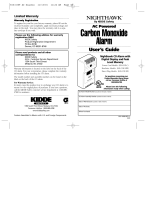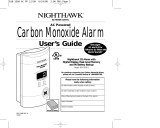TEN YEAR LIMITED WARRANTY
Warranty Coverage: The manufacturer warrants to the original consumer purchaser, that
this product (except battery) will be free of defects in material and workmanship for a period
of ten (10) years from date of purchase. The manufacturer’s liability hereunder is limited to
replacement of the product, repair of the product or replacement of the product with
repaired product at the discretion of the manufacturer. This warranty is void if the product has
been damaged by accident, unreasonable use, neglect, tampering or other causes not arising
from defects in material or workmanship. This warranty extends to the original consumer
purchaser of the product only.
Warranty Disclaimers: Any implied warranties arising out of this sale, including but not
limited to the implied warranties of description, merchantability and fitness for a particular
purpose, are limited in duration to the above warranty period. In no event shall the
Manufacturer be liable for loss of use of this product or for any indirect, special, incidental or
consequential damages, or costs, or expenses incurred by the consumer or any other user of
this product, whether due to a breach of contract, negligence, strict liability in tort or
otherwise. The Manufacturer shall have no liability for any personal injury, property damage
or any special, incidental, contingent or consequential damage of any kind resulting from gas
leakage, fire or explosion. Some states do not allow limitations on how long an implied
warranty lasts, so the above limitation may not apply to you. Some states do not allow the
exclusion or limitation of consequential or incidental damages, so the above limitations or
exclusions may not apply to you.
Legal Remedies: This warranty gives you specific legal rights and you may also have other
rights that vary from state to state.
Warranty Performance: During the above warranty period, your product will be replaced
with a comparable product if the defective product is returned in a postage paid package to
the following address: Kidde, Customer Service Department, 1016 Corporate Park Drive,
Mebane, NC 27302 USA, together with proof of purchase date. Please include a note
describing the problem when you return the unit. The replacement product will be in
warranty for the remainder of the original warranty period or for six months, whichever is
longer. Other than the cost of postage, no charge will be made for replacement of the
defective product. In many cases the quickest way to exchange your monitor is to return it to
the original place of purchase. If you have questions, call Kidde customer service department.
IMPORTANT: Do not remove unit back cover. Back cover removal will void warranty.
Your Kidde Carbon Monoxide Monitor is not a substitute for property, disability, life or other
insurance of any kind. Appropriate insurance coverage is your responsibility. Consult your
insurance agent. Also, Kidde makes no warranty, express or implied, written or oral, including
that of merchantability or fitness for any particular purpose, with respect to the battery.
The above warranty may not be altered except in writing signed by both parties hereto.
QUESTIONS OR FOR MORE INFORMATION
Call Product Support at 1-800-880-6788 or contact
us at our website at www.kidde.com
Kidde, 1016 Corporate Park Drive, Mebane, NC 27302





















